An interview with John Payne
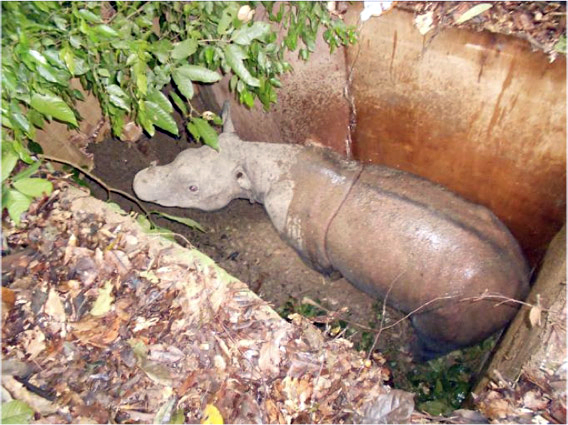
Puntung, a female Sumatran rhino, is captured safely in a pit trap after years of monitoring and planning in Malaysian Borneo. Photo by: Dr Zainal Zahari Zainuddin/BORA.
On December 18th, 2011, a female Sumatran rhino took a sudden plunge. Falling into a manmade pit trap, the rhino may have feared momentarily that her end had come, but vegetation cushioned her fall and the men that found her were keen on saving her, not killing her. Little did she know that conservationists had monitored her since 2006, and for her trappers this moment had been the culmination of years of planning and hope. A few days later she was being airlifted by helicopter to a new home. Puntung, as she has become called, was about to enter a new chapter in her life, one that hopefully will bring about a happy ending for her species.
Few people understood the importance of Puntung more than Dr. John Payne of Borneo Rhino Allliance (BORA). Payne has worked tirelessly for years to save the Sumatran rhino from extinction. In fact he told mongabay.com in 2009 that he had dedicated the rest of his life to keeping this species from vanishing into the dark night of oblivion. Listed as Critically Endangered by the IUCN Red List, Sumatran rhinos (Dicerorhinus sumatrensis) are down to approximately 200 individuals in two subspecies, one found on the island of Sumatra and mainland Malaysia, and the other, known as the Bornean rhino, found in Malaysian Borneo, where Payne works.
“There are too few [Sumatran rhinos] left to survive without bold human intervention,” explains Payne. “The days of leaving Sumatran rhinos in natural habitats and guarding them, hoping that they will not be poached and will breed, are passed. Very few of the remaining rhinos are likely to be fertile. Some of the fertile ones will have no access to a rhino of the opposite sex, because there are almost no rhinos left. Even if these rhinos are not poached, I would guess that maybe 90 percent of the survivors will not breed.”
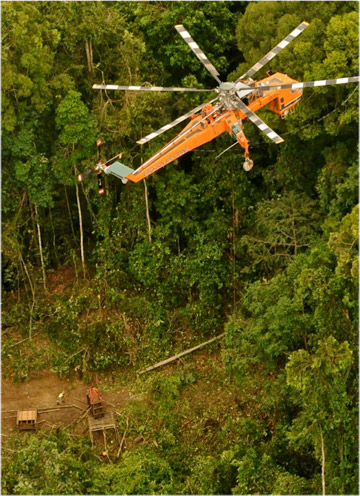 The Erickson air lift helicopter hovers above Puntung in her crate, moments before the lift on December 25th, 2011. Photo by: © Dr Sen Nathan/Sabah Wildlife Department. |
So what do you do? During the 1980s and again since 2008, Payne has been working to develop the Borneo Rhino Sanctuary (BRS), a place where dedicated people could aid wild Sumatran rhinos through breeding efforts, but still keep things as natural as possible, by allowing the animals to remain in their habitat through large, natural enclosures. This program is now being developed by the government of Sabah (via Sabah Wildlife Department) and a dedicated non-governmental organization, BORA, To date, the program lacks a long-term facility, but there is a male Sumatran rhino, Tam, who wandered into a palm oil plantation in 2008. And now with the successful capture of Puntung, the program has a female rhino that is probably capable of breeding. Before her capture, Puntung was closely monitored, allowing the BORA team to note her condition and discover that she was the only rhino living in a 1,500 hectare part of a contiguous 120,000 hectare forest, with no chance of running into another rhino. If left alone, she would’ve died without even a chance at reproduction. Not only has Puntung been lucky, but has already proven herself a survivor: she is missing her left front foot.
“The only possible explanation is that she lost it in a poacher’s snare trap. In fact, about half the rhinos captured in Malaysia over the past few decades showed signs of injuries on the leg resulting from escape from a snare trap. Probably most rhinos that have died over the past few decades in Malaysia, other than some from old age, have died as a result of getting a foot caught in a snare trap,” explains Payne, who says Puntung was fortunate to survivor the snaring.
“This injury must have occurred when she was very young, and mother’s milk would have provided the necessary nutrition to just allow her to survive, and the foot to heal. The fact that Puntung has lived probably for a decade or more with much of her weight born on her front right foot has meant that the muscling on and around the left leg is atrophied while that on the right is over-developed in compensation.”
Despite Puntung’s tenacity, the leg may be an issue when it comes time to breed. Female rhinos are mounted by males, and conservationists are concerned that Puntung may not be able to bear Tam’s full weight. In this case, artificial insemination may be tried or a harness may be built.
So, after years of working with the government, wildlife agencies, and the private sector, Payne and his team have acquired two breeding rhinos, but they hope for more: the program is now waiting for the Sabah government to build promised permanent facilities for the rhinos.
“Our biggest constraint now is that the permanent Borneo Rhino Sanctuary facilities have yet to be built. […] Funded by Sime Darby Foundation and WWF-Germany, interim facilities have been built, but these can hold only three rhinos. We are reluctant to put more money into yet more interim facilities, money that could be spent on developing the program and on all the non-infrastructure costs. However, we (Sabah Wildlife Department, BORA and WWF-Malaysia) do aim to catch at least one additional rhino during 2012. At least one new trap will be out in a new area by early May 2012,” Payne says.
There are a lot of ifs in the future: if Tam and Puntung are able to mate; if Puntung becomes pregnant; if the child survives to birth (a major concern with the species, which often suffers miscarriages); if a new facility can be built to house the family… But the program finally has a chance to succeed. With the capture of Puntung, dubbed the “Christmas Miracle”, conservationists have for the first time in decades a chance to save the species from slow, but inevitable, extinction.
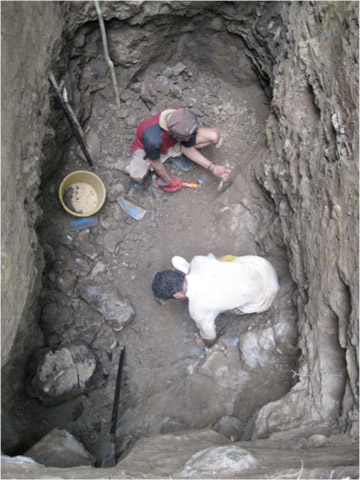 Digging the pit for the trap, December 2011. Chisels were used to loosen and gouge out the rock to a depth of 8 feet. Photo by: © J Payne/BORA. |
Payne is not the only one working to save the species. On the island of Sumatra a similar program is underway with conservationists having recently announced the third pregnancy for female rhino, Ratu, who lost her previous two babies in miscarriages. Together it’s hoped that these two programs may create a viable population.
“The good news is that it should be clear within less than 10 years from now whether there is a chance to save the species or not,” says Payne. “Without a few rhino births both in the wild and in fenced, managed conditions, within the next decade, then the species is definitely doomed. So if nothing has changed by 2022, the older people now involved in the program can retire leaving a legacy of having tried their best, and the younger ones can go to do something else.”
In an April interview, John Payne discusses the exciting capture of Puntung, learning from past breeding failures, and how palm oil companies have helped give the species a second chance.
INTERVIEW WITH JOHN PAYNE
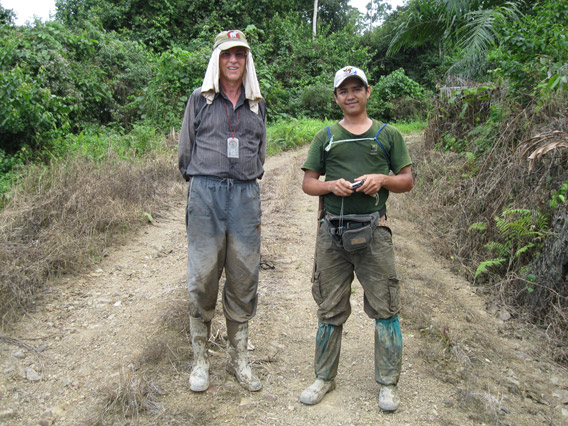
John Payne (left) with BORA field team leader Tinrus Tindok. Photo courtesy of John Payne.
Mongabay: What is your background?
John Payne: I remember the founding of WWF (World Wildlife Fund) in 1961 when I was 7 years old. There was a photo on the front page of the Daily Mirror, a British newspaper, showing a mother and calf Black Rhino, and I had just started reading voraciously, and the purpose of WWF was announced. It was to do whatever necessary in raising funds and supplying expertise to save critically endangered wildlife species in situations where governments were unable or unwilling to do so. I think that probably cemented my future because I could see from that what I was passionate about (maybe passionate is the wrong word for a seven year old—more like fixated and wanting to see and read the same thing again and again) and the means to do it—via working for WWF. During school vacations between 1969-72 I volunteered as a fundraiser for WWF by bringing a money collecting box house to house in my home town in Haywards Heath, England. Then I went to King’s College London and obtained a degree in zoology in 1975. I realized at university that a good route towards a career in tropical wildlife conservation would be to do field work for a doctoral degree in a tropical country. Being before the days of internet, the way to do that was to write letters to people whose name and address was in the local public library, and who were doing something at the time in a tropical country. The only positive response I received was from John MacKinnon, who put me in touch with David Chivers of Cambridge University, who, working his customary magic, obtained for me a grant from the British government’s Science Research Council to do a PhD at Cambridge with field work in Malaysia.
Mongabay: What are the challenges facing the Bornean rhino?
John Payne: The main challenge is that there are too few left to survive without bold human intervention. The days of leaving Sumatran rhinos in natural habitats and guarding them, hoping that they will not be poached and will breed, are passed. Very few of the remaining rhinos are likely to be fertile. Some of the fertile ones will have no access to a rhino of the opposite sex, because there are almost no rhinos left. Even if these rhinos are not poached, I would guess that maybe 90% of the survivors will not breed. In fact, a program to form a globally managed breeding population of Sumatran rhinos was initiated in 1983, and endorsed at a IUCN chaired meeting in Singapore in 1984. Forty rhinos were subsequently caught in Indonesia and Malaysia between 1985-94. Due to a combination of lack of imagination, individual egos, and unwillingness to take necessary steps, the program failed, although Cincinnati Zoo managed to produce three offspring from a single rhino pair from Sumatra. What is happening now is the very last try to revive that program. If this one fails, we give up. The good news is that it should be clear within less than 10 years from now whether there is a chance to save the species or not. Without a few rhino births both in the wild and fenced, managed conditions, within the next decade, then the species is definitely doomed. So if nothing has changed by 2022, the older people now involved in the program can retire leaving a legacy of having tried their best, and the younger ones can go to do something else.
PUNTUNG
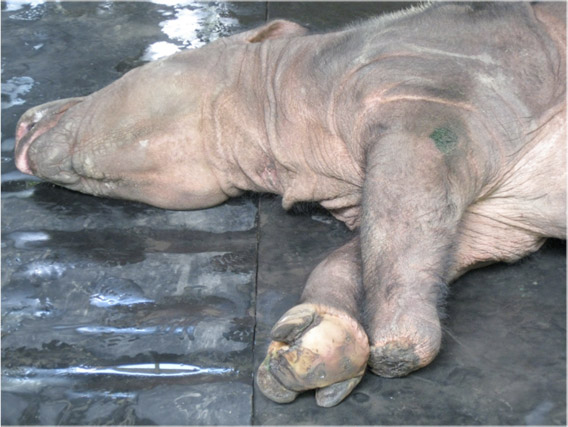
Puntung, showing her normal right foot and left leg ending in a stump. Photo by: John Payne.
Mongabay: How did you find Puntung?
John Payne: The field teams of SOS Rhino Borneo (the former name for the entity which was founded by Dr Nan Schaffer and which is now called Borneo Rhino Alliance) started finding and recognizing her distinctive footprints more than six years ago. Occasionally, she was glimpsed wallowing or walking in the forest, and video was obtained by the SOS Rhino Borneo team in 2007. The sightings allowed us to be sure that she was female. By 2010, there was no evidence of any other rhino in her home range, and it was reasonable to conclude that she would not breed if left in the wild.
Mongabay: Will you tell us about Puntung’s injuries? Will this impact breeding at all?
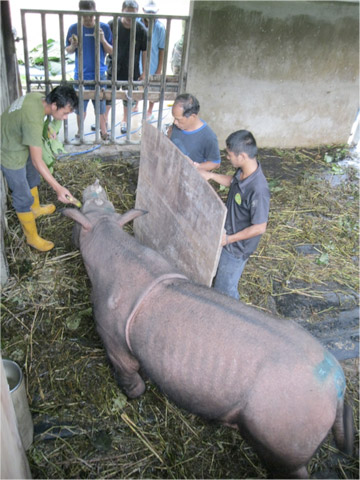 Puntung being coaxed on to scales to take her weight on 26 December 2011. © John Payne/BORA. |
John Payne: She is missing her front left foot, including the hoofs. The only possible explanation is that she lost it in a poacher’s snare trap. In fact, about half the rhinos captured in Malaysia over the past few decades showed signs of injuries on the leg resulting from escape from a snare trap. Probably most rhinos that have died over the past few decades in Malaysia, other than some from old age, have died as a result of getting a foot caught in a snare trap. Snares may be set by hunters deliberately targeting rhinos, but commonly the traps are set by workers in plantations and in logging camps, who just want to get free meat, but end up with a dead or injured rhino instead of pork or venison. In Puntung, this injury must have occurred when she was very young, and mother’s milk would have provided the necessary nutrition to just allow her to survive, and the foot to heal. The fact that Puntung has lived probably for a decade or more with much of her weight born on her front right foot has meant that the muscling on and around the left leg is atrophied while that on the right is over-developed in compensation. It is not clear at this stage whether this debility might inhibit or prevent natural breeding, either during mating or during any pregnancy that might ensue.
Mongabay: Now that you have a female for Tam to potentially breed with what are the next steps?
John Payne: Puntung’s general condition, blood parameters, hormone levels and reproductive tract appearance (by ultrasound) will be monitored over several months before decisions are made on how to maximize her prospects for producing baby rhinos.
Mongabay: What happens if Puntung is infertile?
John Payne: Prospects currently look quite good. It is not expected that she will be infertile. The more likely problems will come in relation to how to deal with her if her physical debility or the reproductive tract pathology that plagues most female Sumatran rhinos makes natural breeding too risky.
BREEDING

Puntung’s breeding partner is Tam, pictured here, who was found in palm oil plantation in 2008, also with a foot injured by a snare. Photo by: Jeremy Hance.
Mongabay: You have other rhinos that you know of which may be suitable for the breeding facility. How do you determine when you should try catching them?
John Payne: Our biggest constraint now is that the permanent Borneo Rhino Sanctuary facilities have yet to be built. Despite the Sabah Development Corridor program of 2008, and agreements between Government of Sabah with Sime Darby Foundation and with BORA, whereby government is responsible to build these facilities, there is still no sign of progress. Funded by Sime Darby Foundation and WWF-Germany, interim facilities have been built, but these can hold only three rhinos. We are reluctant to put more money into interim facilities, money that could be spent on developing the program and on all the non-infrastructure costs. However, we (Sabah Wildlife Department, BORA and WWF-Malaysia) do aim to catch at least one additional rhino during 2012. At least one new trap will be out in a new area by early May 2012.
Mongabay: How difficult is it to catch a Bornean rhino?
John Payne: It always was difficult, and now it is nearly impossible. There are several reasons for this. One is that there are hardly any rhinos left from which to select a candidate. Those that remain live either in extensive swamps or steep hills or in remote areas, and/or in protected areas, from which there is opposition to capture of any large animal. So far, the only successful method for capture of targeted Sumatran rhinos has been pit traps—digging big holes in the ground. Actually, that part is much less risky than it might seem. The trap is bedded with thick layer of leaves and twigs to break the fall.
Mongabay: If all else fails, what technological advances could Sabah take advantage of?
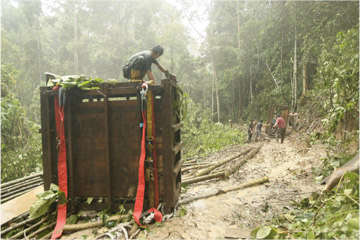 Continual rain throughout 24 December prevented the planned air lift site on that day. Photo by: © Azrie Alliamat / ITBC, Universiti Malaysia Sabah. |
John Payne: The Leibniz Institute for Zoo and Wildlife Research (Berlin) has an agreement with Sabah Wildlife Department to provide technical assistance and advice. It is possible to freeze and retain sperm, ova and embryos in liquid nitrogen. Artificial insemination has been used successfully in White and Indian rhinos.
Mongabay: What is your vision of the proposed Borneo Rhino Sanctuary (BRS) breeding facility?
John Payne: I am doubtful if governments can operate the sorts of facilities and the 100 percent disciplined human resources and standard operating procedures needed for BRS. This is not said to put Government of Malaysia or Sabah in a bad light. It is just how things are with all governments. No governments operate via passion, small democratic groups, technocrats over-ruling bureaucrats, quick changes of plan, people working day after day at night and weekends. Only NGOs and corporation can do that. WWF was set up in 1961 because the founders knew this (although WWF has subsequently turned away from doing whatever is necessary to save critically endangered species from extinction). The government-run Sumatran Rhino Sanctuary at Sungai Dusun in Peninsular Malaysia allowed its rhinos to die from poor hygiene. Cincinnati Zoo successfully kept and bred Sumatran Rhinos. Let’s hope government will accept this, and delegate operations 100 percent to an alliance of NGO and corporation.
In terms of funding, it might be possible to periodically remove parts of the rhinos’ horns (they will regrow), and auction them internationally. That would just about provide enough funds to sustain operations once everything is in place. However, I recognize that there are good reasons why this would not be a good idea, when the global picture of rhino conservation is considered. Probably, the idea is a non-starter, but I am not keen on totally dismissing options when there are very few options available. I do not believe that rhino horn has any medicinal properties, but thousands of people with more money than sense do so. At this stage I doubt that this idea can materialize, however, as too many people would be against the idea both in Malaysia and globally, and at least some might have good reasons for their objections, starting with implementation of CITES.
Mongabay: The Sabah government promised the Borneo Rhino Sanctuary (BRS) breeding facility in 2008. What’s holding up the construction?
John Payne: I cannot imagine. Better ask the government of Sabah.
Mongabay: Have there been discussions related to crossbreeding the Bornean rhinos with Sumatran rhinos, of which they are a subspecies?
John Payne: It is uncertain that the division of the Sumatran and Bornean rhinos into two sub-species can be justified. DNA shows that the Bornean form is only slightly more different from the Sumatran than the Sumatran is from the Peninsular Malaysia form. The division into sub-species was made by Colin Groves in 1965, based on measurements of the skulls of five Bornean, 2 Sumatran and 4 Peninsular Malaysia rhinos, and the only difference was that the the Bornean was smaller and had a slightly different shape. People have uncritically accepted that ever since, even though the size of rhinos is linked more to soil fertility and food quality than to genetics. The logic now is simple: if mixing Sumatran and Bornean forms can result in more baby rhinos than if no mixing were to be allowed, then we should mix.
CONSERVATION GOING AHEAD

Puntung in her temporary stockade before being airlifted, 20 December 2011. © Herman Stawin/Sabah Wildlife Department.
Mongabay: You have stated that palm oil is no longer a threat to Bornean rhinos, but is it one of the reasons behind their current state of near-extinction?
John Payne: In my opinion no. The species was already extremely rare and endangered in Sabah by 1980, before the big expansion of oil palm.
Mongabay: How have palm oil companies been helping the Bornean rhino conservation efforts?
John Payne: The big help has come from Sime Darby Foundation, which is operated separately and independently from its parent company, but of course sale of palm oil is the company’s single biggest income earner. BORA is comfortable to be associated with this company because it is one of the big palm oil producers which is an active member of the Round Table on Sustainable Palm Oil, and as of 2011 had produced 30 percent of global production of palm oil certified under RSPO standards. Sime Darby Foundation has committed 11.4 million Malaysian ringgit (about US$3.8 million) to development of the Borneo Rhino Sanctuary program over the period 2009-2015. Wilmar has contributed via fielding of a law enforcement team in its Sabahmas estate which borders Tabin Wildlife Reserve. If every estate surrounding forests with rhinos would do the same, concerns over rhino poaching would be very much less, and would relieve the burden on government.
Mongabay: With Puntung on the scene, the Bornean rhino has received considerable press in Sabah. Do you feel the public and government are more invested in doing what it takes to save the rhino?
John Payne: Yes they are.
Mongabay: How can people help this project?
John Payne: (1) Think critically of the issues associated with preventing the extinction of the Sumatran rhino. and make comments only after careful thought. There is the potential for well-meaning people to say the wrong thing. In 1985, several well-meaning but ultimately destructive individuals objected to Sabah working with US zoos, which meant that a carefully drawn up plan, already agreed by Government of Sabah in 1984, was thrown out by a new government in 1985, without any “Plan B” in place. It is now impossible to say if there would have been a successful outcome if the original plan had been pursued, but the 1985 hurriedly drawn up Plan B (forming a committee and going it alone without foreign help) certainly played a big role in leaving us in the dire pickle in which the species now finds itself in Sabah. (2) In commenting on conservation issues in Malaysia, lay off the bandwagon generic issues (oil palm, carbon, high conservation value forest, law enforcement etc.) which are never fully solved and which will eventually be sorted out, and instead go for focused, specific issues, such as the need to pull out all stops now for Sumatran rhinos.
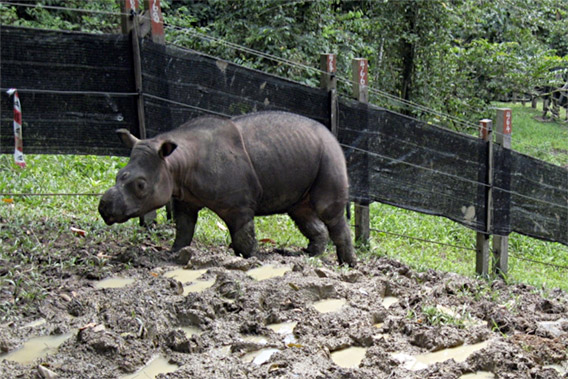
Puntung, entering her forest paddock from her night stall. Walking on wet clay soil is good for her comfort and the condition of her front feet. Photo by: © John Payne/BORA.
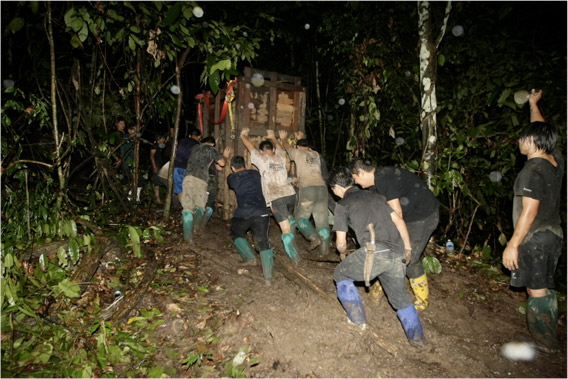
Moving Puntung with a lot of human power from the temporary forest stockade to the air lift site, through the night of 23-24 December 2011. Photo by: © Azrie Alliamat/ITBC, Universiti Malaysia Sabah.

Tam eating lunch in his night pen. Photo by: Jeremy Hance.
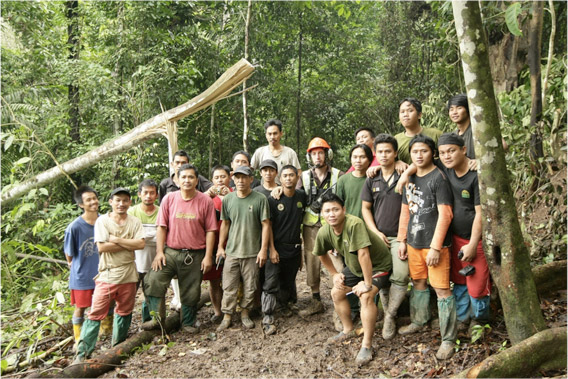
Rhino heroes: having run out of food except for instant noodles, the trap site team pose for a photo before the airlift on morning of 25 December 2011. Photo by: © Azrie Alliamat/ITBC, Universiti Malaysia Sabah.
Related articles
‘Christmas miracle’ for endangered rhinos
(12/24/2011) Conservationists and wildlife officials in the Malaysian state of Sabah airlifted a young female Sumatran Rhinoceros — one of the world’s most endangered animals — to an area of forest where she would encounter a potential partner, reports the Sabah Wildlife Department and Borneo Rhino Alliance. Sumatran Rhinoceros populations are so low, some individuals live in areas where they have no hope of ever finding another rhino.
Kruger National Park loses 95 rhinos to poachers in three months

(04/05/2012) Since the first of the year, South Africa’s Kruger National Park has lost 95 rhinos to poachers, reports the blog Rhino Horn is NOT Medicine. South Africa, and Kruger National Park in particular, continue to be the epicenter for rhino poaching worldwide. South Africa has lost 159 rhinos in total this year with Kruger bearing nearly 60 percent of the fatalities.
Sumatran rhino pregnant: conservationists hope third time’s the charm
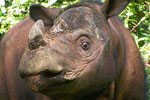
(02/07/2012) Ratu, a female Sumatra rhino (Dicerorhinus sumatrensis), is in the eleventh month of her third pregnancy raising hopes for a successful birth of one of the world’s most imperiled big mammals. Ratu suffered two prior miscarriages, but researchers believe the current pregnancy—which still has four to five months to go (for a total term of around 15-16 months)—could produce what Indonesian officials have long hoped for: a bundle of joy at the Sumatran Rhino Sanctuary in Sumatra. With only around 200 Sumatran rhinos surviving today in Indonesia and Bornean Malaysia, many conservationists see such breeding efforts as the last and best chance to save the Critically Endangered species from extinction.
Camera traps snap 35 Javan rhinos, including calves
(01/04/2012) Camera traps have successfully taken photos of 35 Javan rhinos (Rhinoceros sondaicus) in Ujung Kulon National Park. The small population, with an estimated 45 or so individuals, is the species’ last stand against extinction. Late last year, a subspecies of the Javan rhino, the Vietnamese rhino (Rhinoceros sondaicus annamiticus), was declared extinct.
A final farewell: the Western Black Rhino goes extinct
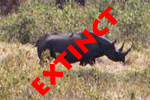
(11/12/2011) The western black rhinoceros (Diceros bicornis longipes) roams the woodlands of Africa no more. The rhino, one of four sub-species of black rhino, was declared extinct this week by the IUCN, five years after the last extensive survey of its habitat in Cameroon. The rhino becomes the second declared extinct this year. All rhinos are threatened by the rhino horn trade.
Malaysia must take action to avoid extinction of its last rhinos
(11/05/2011) Malaysia must take immediate action to prevent the extinction of the handful of rhinos that survive on the island of Borneo, says a coalition of environmental groups.
South Africa hits record poaching of rhinos—again
(11/03/2011) Two months before the end of the year, the number of rhinos killed for their horns in South Africa has surpassed last year’s breaking record, reports conservation organizations WWF and TRAFFIC. So far, 341 rhinos have been lost to poaching this year; while last year saw a total record of 333. The news follows last week’s announcement that the Vietnamese rhino (Rhinoceros sondaicus annamiticus), a subspecies of the Javan rhino, has gone extinct—the last individual killed by a poachers’ bullet. Rhinos are killed for their horns which are used in traditional Chinese medicine, even though numerous studies have shown there is no medicinal benefit to consuming rhino horn.
The last goodbye: Vietnam’s rhino goes extinct (PICTURES)
(10/26/2011) In 2009 poachers shot and killed the world’s last Vietnamese rhinoceros (Rhinoceros sondaicus annamiticus), a subspecies of the Javan rhino. The Vietnamese rhino was the last rhino species that survived on the southeast Asia mainland.
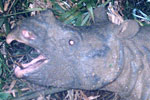
(10/25/2011) In 2009 poachers shot and killed the world’s last Vietnamese rhinoceros (Rhinoceros sondaicus annamiticus), a subspecies of the Javan rhino, confirms a report from International Rhino Foundation (IRF) and the World Wide Fund for Nature (WWF). The Vietnamese rhino was the last Javan rhino to survive on the Asian mainland and the second subspecies to vanish, following the extinction of the Indian Javan rhino (rhinoceros sondaicus inermis). The Javan rhino is the world’s most imperiled rhino species with now only around 50 individuals surviving in a single park on its namesake island in Indonesia.
How do we save the Sumatran rhino?

(06/06/2011) Some conservation challenges are more daunting than others. For example, how do you save a species that has been whittled down to just a couple hundred individuals; still faces threats such as deforestation, poaching and trapping; is notoriously difficult to breed in captivity; and is losing precious time because surviving animals are so few and far-apart that simply finding one another—let alone mating and successfully bringing a baby into the world—is unlikely? This is the uphill task that faces conservationists scrambling to save the Sumatran rhino (Dicerorhinus sumatrensis). A new paper in Oryx, aptly named Now or never: what will it take to save the Sumatran rhinoceros Dicerorhinus sumatrensis from extinction? analyzes the conservation challenge, while putting forth a number of recommendations.